Yanzhen Ren
Audio-visual Event Localization on Portrait Mode Short Videos
Apr 09, 2025Abstract:Audio-visual event localization (AVEL) plays a critical role in multimodal scene understanding. While existing datasets for AVEL predominantly comprise landscape-oriented long videos with clean and simple audio context, short videos have become the primary format of online video content due to the the proliferation of smartphones. Short videos are characterized by portrait-oriented framing and layered audio compositions (e.g., overlapping sound effects, voiceovers, and music), which brings unique challenges unaddressed by conventional methods. To this end, we introduce AVE-PM, the first AVEL dataset specifically designed for portrait mode short videos, comprising 25,335 clips that span 86 fine-grained categories with frame-level annotations. Beyond dataset creation, our empirical analysis shows that state-of-the-art AVEL methods suffer an average 18.66% performance drop during cross-mode evaluation. Further analysis reveals two key challenges of different video formats: 1) spatial bias from portrait-oriented framing introduces distinct domain priors, and 2) noisy audio composition compromise the reliability of audio modality. To address these issues, we investigate optimal preprocessing recipes and the impact of background music for AVEL on portrait mode videos. Experiments show that these methods can still benefit from tailored preprocessing and specialized model design, thus achieving improved performance. This work provides both a foundational benchmark and actionable insights for advancing AVEL research in the era of mobile-centric video content. Dataset and code will be released.
SE4Lip: Speech-Lip Encoder for Talking Head Synthesis to Solve Phoneme-Viseme Alignment Ambiguity
Apr 08, 2025Abstract:Speech-driven talking head synthesis tasks commonly use general acoustic features (such as HuBERT and DeepSpeech) as guided speech features. However, we discovered that these features suffer from phoneme-viseme alignment ambiguity, which refers to the uncertainty and imprecision in matching phonemes (speech) with visemes (lip). To address this issue, we propose the Speech Encoder for Lip (SE4Lip) to encode lip features from speech directly, aligning speech and lip features in the joint embedding space by a cross-modal alignment framework. The STFT spectrogram with the GRU-based model is designed in SE4Lip to preserve the fine-grained speech features. Experimental results show that SE4Lip achieves state-of-the-art performance in both NeRF and 3DGS rendering models. Its lip sync accuracy improves by 13.7% and 14.2% compared to the best baseline and produces results close to the ground truth videos.
Improving Speech Enhancement by Cross- and Sub-band Processing with State Space Model
Feb 22, 2025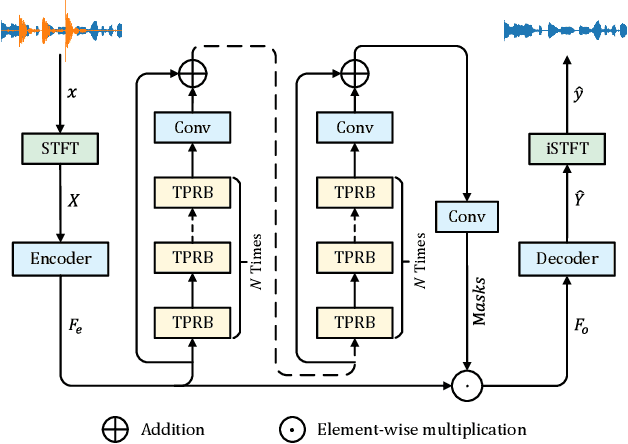
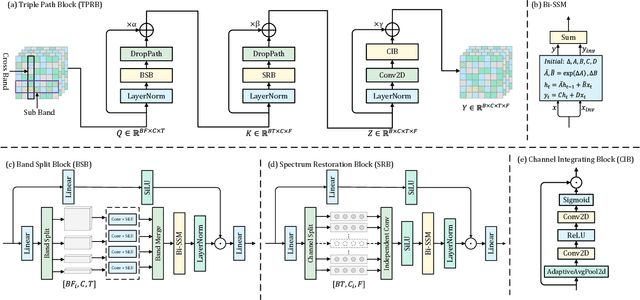

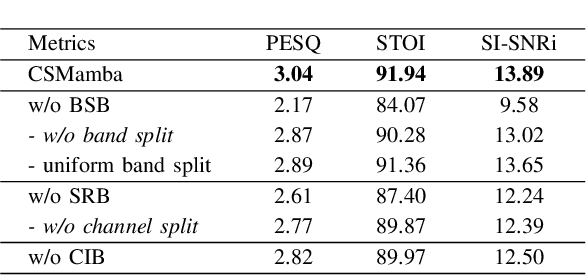
Abstract:Recently, the state space model (SSM) represented by Mamba has shown remarkable performance in long-term sequence modeling tasks, including speech enhancement. However, due to substantial differences in sub-band features, applying the same SSM to all sub-bands limits its inference capability. Additionally, when processing each time frame of the time-frequency representation, the SSM may forget certain high-frequency information of low energy, making the restoration of structure in the high-frequency bands challenging. For this reason, we propose Cross- and Sub-band Mamba (CSMamba). To assist the SSM in handling different sub-band features flexibly, we propose a band split block that splits the full-band into four sub-bands with different widths based on their information similarity. We then allocate independent weights to each sub-band, thereby reducing the inference burden on the SSM. Furthermore, to mitigate the forgetting of low-energy information in the high-frequency bands by the SSM, we introduce a spectrum restoration block that enhances the representation of the cross-band features from multiple perspectives. Experimental results on the DNS Challenge 2021 dataset demonstrate that CSMamba outperforms several state-of-the-art (SOTA) speech enhancement methods in three objective evaluation metrics with fewer parameters.
FA-GAN: Artifacts-free and Phase-aware High-fidelity GAN-based Vocoder
Jul 05, 2024Abstract:Generative adversarial network (GAN) based vocoders have achieved significant attention in speech synthesis with high quality and fast inference speed. However, there still exist many noticeable spectral artifacts, resulting in the quality decline of synthesized speech. In this work, we adopt a novel GAN-based vocoder designed for few artifacts and high fidelity, called FA-GAN. To suppress the aliasing artifacts caused by non-ideal upsampling layers in high-frequency components, we introduce the anti-aliased twin deconvolution module in the generator. To alleviate blurring artifacts and enrich the reconstruction of spectral details, we propose a novel fine-grained multi-resolution real and imaginary loss to assist in the modeling of phase information. Experimental results reveal that FA-GAN outperforms the compared approaches in promoting audio quality and alleviating spectral artifacts, and exhibits superior performance when applied to unseen speaker scenarios.
Semantic Proximity Alignment: Towards Human Perception-consistent Audio Tagging by Aligning with Label Text Description
Sep 28, 2023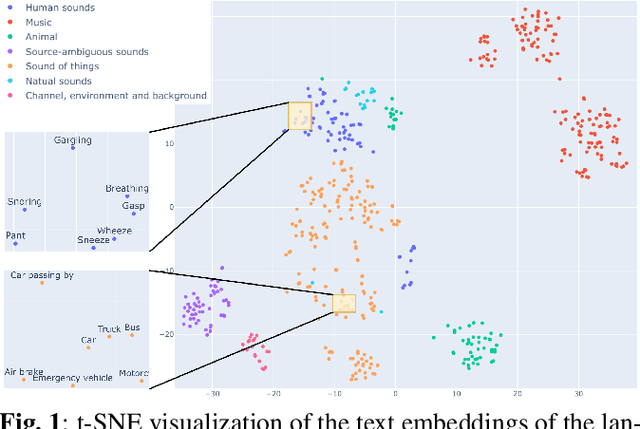
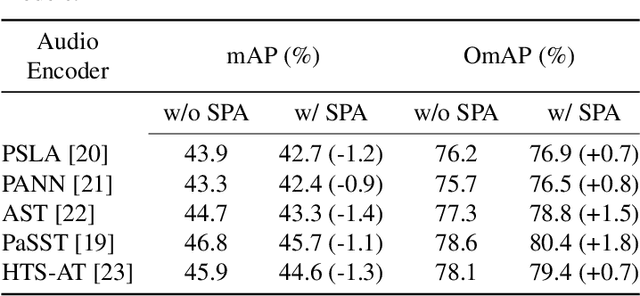
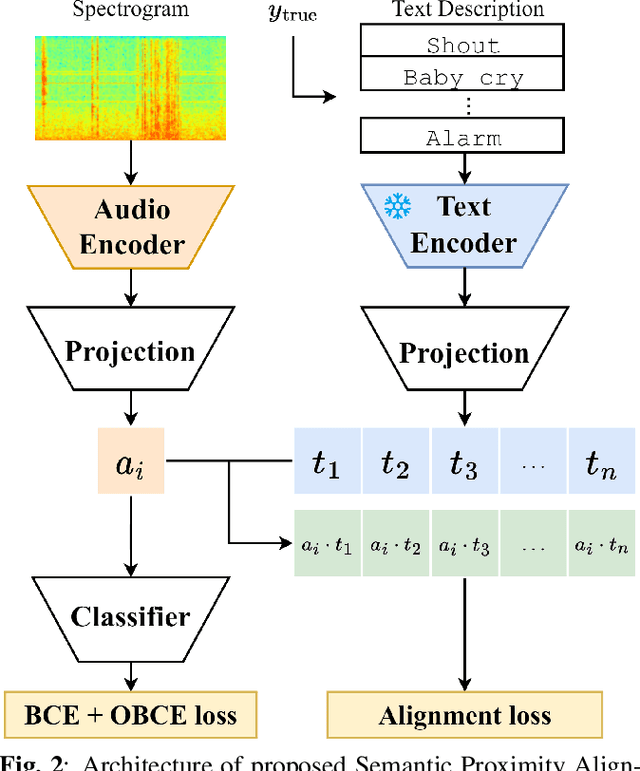
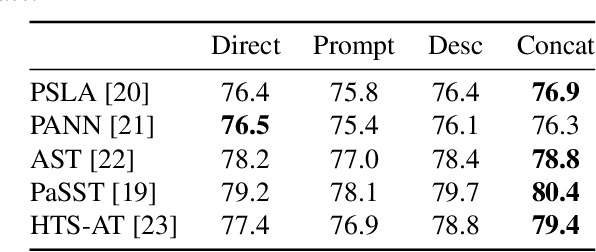
Abstract:Most audio tagging models are trained with one-hot labels as supervised information. However, one-hot labels treat all sound events equally, ignoring the semantic hierarchy and proximity relationships between sound events. In contrast, the event descriptions contains richer information, describing the distance between different sound events with semantic proximity. In this paper, we explore the impact of training audio tagging models with auxiliary text descriptions of sound events. By aligning the audio features with the text features of corresponding labels, we inject the hierarchy and proximity information of sound events into audio encoders, improving the performance while making the prediction more consistent with human perception. We refer to this approach as Semantic Proximity Alignment (SPA). We use Ontology-aware mean Average Precision (OmAP) as the main evaluation metric for the models. OmAP reweights the false positives based on Audioset ontology distance and is more consistent with human perception compared to mAP. Experimental results show that the audio tagging models trained with SPA achieve higher OmAP compared to models trained with one-hot labels solely (+1.8 OmAP). Human evaluations also demonstrate that the predictions of SPA models are more consistent with human perception.
A Snoring Sound Dataset for Body Position Recognition: Collection, Annotation, and Analysis
Jul 25, 2023



Abstract:Obstructive Sleep Apnea-Hypopnea Syndrome (OSAHS) is a chronic breathing disorder caused by a blockage in the upper airways. Snoring is a prominent symptom of OSAHS, and previous studies have attempted to identify the obstruction site of the upper airways by snoring sounds. Despite some progress, the classification of the obstruction site remains challenging in real-world clinical settings due to the influence of sleep body position on upper airways. To address this challenge, this paper proposes a snore-based sleep body position recognition dataset (SSBPR) consisting of 7570 snoring recordings, which comprises six distinct labels for sleep body position: supine, supine but left lateral head, supine but right lateral head, left-side lying, right-side lying and prone. Experimental results show that snoring sounds exhibit certain acoustic features that enable their effective utilization for identifying body posture during sleep in real-world scenarios.
Who is Speaking Actually? Robust and Versatile Speaker Traceability for Voice Conversion
May 09, 2023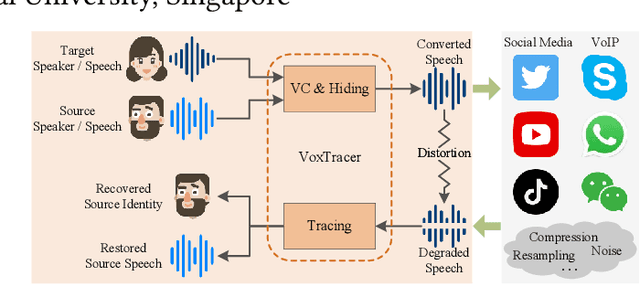

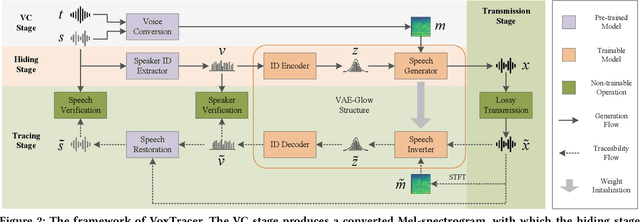
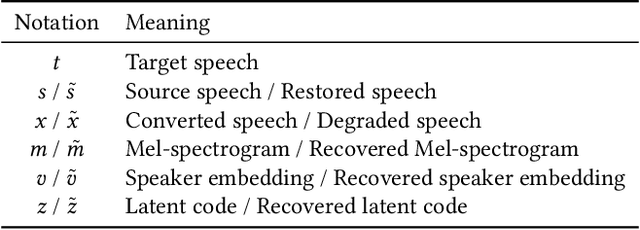
Abstract:Voice conversion (VC), as a voice style transfer technology, is becoming increasingly prevalent while raising serious concerns about its illegal use. Proactively tracing the origins of VC-generated speeches, i.e., speaker traceability, can prevent the misuse of VC, but unfortunately has not been extensively studied. In this paper, we are the first to investigate the speaker traceability for VC and propose a traceable VC framework named VoxTracer. Our VoxTracer is similar to but beyond the paradigm of audio watermarking. We first use unique speaker embedding to represent speaker identity. Then we design a VAE-Glow structure, in which the hiding process imperceptibly integrates the source speaker identity into the VC, and the tracing process accurately recovers the source speaker identity and even the source speech in spite of severe speech quality degradation. To address the speech mismatch between the hiding and tracing processes affected by different distortions, we also adopt an asynchronous training strategy to optimize the VAE-Glow models. The VoxTracer is versatile enough to be applied to arbitrary VC methods and popular audio coding standards. Extensive experiments demonstrate that the VoxTracer achieves not only high imperceptibility in hiding, but also nearly 100% tracing accuracy against various types of audio lossy compressions (AAC, MP3, Opus and SILK) with a broad range of bitrates (16 kbps - 128 kbps) even in a very short time duration (0.74s). Our speech demo is available at https://anonymous.4open.science/w/DEMOofVoxTracer.
Hiding Data in Colors: Secure and Lossless Deep Image Steganography via Conditional Invertible Neural Networks
Jan 19, 2022



Abstract:Deep image steganography is a data hiding technology that conceal data in digital images via deep neural networks. However, existing deep image steganography methods only consider the visual similarity of container images to host images, and neglect the statistical security (stealthiness) of container images. Besides, they usually hides data limited to image type and thus relax the constraint of lossless extraction. In this paper, we address the above issues in a unified manner, and propose deep image steganography that can embed data with arbitrary types into images for secure data hiding and lossless data revealing. First, we formulate the data hiding as an image colorization problem, in which the data is binarized and further mapped into the color information for a gray-scale host image. Second, we design a conditional invertible neural network which uses gray-scale image as prior to guide the color generation and perform data hiding in a secure way. Finally, to achieve lossless data revealing, we present a multi-stage training scheme to manage the data loss due to rounding errors between hiding and revealing processes. Extensive experiments demonstrate that the proposed method can perform secure data hiding by generating realism color images and successfully resisting the detection of steganalysis. Moreover, we can achieve 100% revealing accuracy in different scenarios, indicating the practical utility of our steganography in the real-world.
Generalized Local Optimality for Video Steganalysis in Motion Vector Domain
Dec 22, 2021
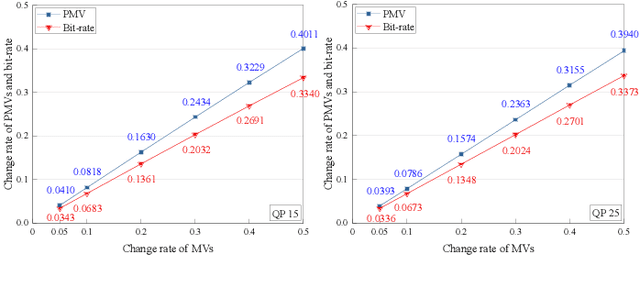
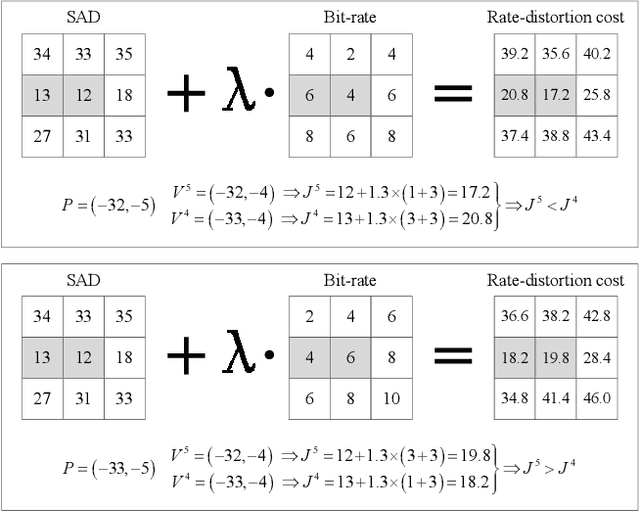
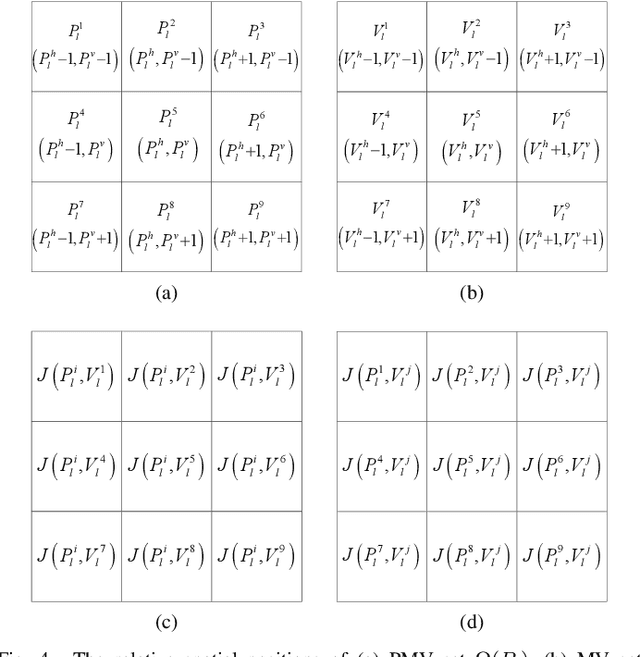
Abstract:The local optimality of motion vectors (MVs) is an intrinsic property in video coding, and any modifications to the MVs will inevitably destroy this optimality, making it a sensitive indicator of steganography in the MV domain. Thus the local optimality is commonly used to design steganalytic features, and the estimation for local optimality has become a top priority in video steganalysis. However, the local optimality in existing works is often estimated inaccurately or using an unreasonable assumption, limiting its capability in steganalysis. In this paper, we propose to estimate the local optimality in a more reasonable and comprehensive fashion, and generalize the concept of local optimality in two aspects. First, the local optimality measured in a rate-distortion sense is jointly determined by MV and predicted motion vector (PMV), and the variability of PMV will affect the estimation for local optimality. Hence we generalize the local optimality from a static estimation to a dynamic one. Second, the PMV is a special case of MV, and can also reflect the embedding traces in MVs. So we generalize the local optimality from the MV domain to the PMV domain. Based on the two generalizations of local optimality, we construct new types of steganalytic features and also propose feature symmetrization rules to reduce feature dimension. Extensive experiments performed on three databases demonstrate the effectiveness of the proposed features, which achieve state-of-the-art in both accuracy and robustness in various conditions, including cover source mismatch, video prediction methods, video codecs, and video resolutions.
Using contrastive learning to improve the performance of steganalysis schemes
Mar 01, 2021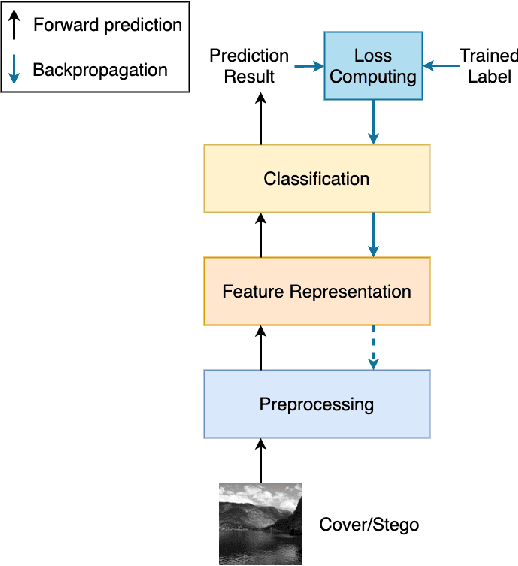

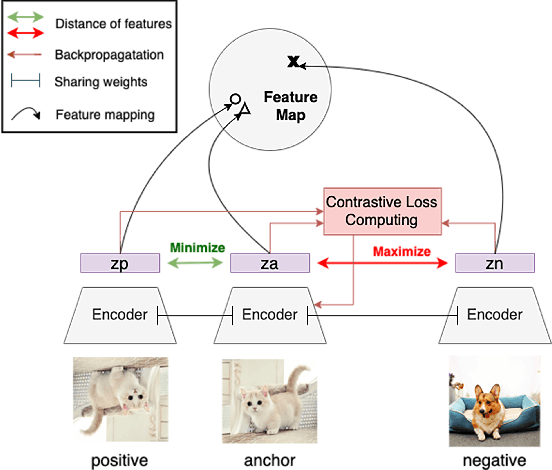

Abstract:To improve the detection accuracy and generalization of steganalysis, this paper proposes the Steganalysis Contrastive Framework (SCF) based on contrastive learning. The SCF improves the feature representation of steganalysis by maximizing the distance between features of samples of different categories and minimizing the distance between features of samples of the same category. To decrease the computing complexity of the contrastive loss in supervised learning, we design a novel Steganalysis Contrastive Loss (StegCL) based on the equivalence and transitivity of similarity. The StegCL eliminates the redundant computing in the existing contrastive loss. The experimental results show that the SCF improves the generalization and detection accuracy of existing steganalysis DNNs, and the maximum promotion is 2% and 3% respectively. Without decreasing the detection accuracy, the training time of using the StegCL is 10% of that of using the contrastive loss in supervised learning.
 Add to Chrome
Add to Chrome Add to Firefox
Add to Firefox Add to Edge
Add to Edge